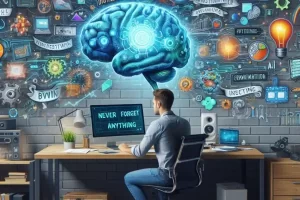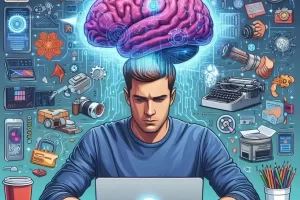Ideas are powerful — but they’re worthless if they never leave your head. Most people have brilliant insights, project ideas, or content concepts that get lost in notebooks, sticky notes, or digital clutter. That’s why capturing, organizing, and acting on ideas is a core function of your second brain, especially when paired with artificial intelligence (AI).
In this article, you’ll learn how to use your second brain and AI to consistently transform ideas into real-world results — whether that’s a business, article, product, or personal project.
Why Ideas Die Without a System
You’ve likely had great ideas that:
- Got forgotten before you could capture them
- Were captured, but never developed
- Felt overwhelming to start
- Lacked a clear next step
- Were repeated months later because you didn’t realize you already had them
A second brain helps by:
- Capturing ideas instantly
- Organizing them by theme or potential
- Linking them to action steps or projects
- Tracking their evolution from seed to execution
AI helps by:
- Developing raw ideas into outlines
- Prioritizing ideas based on relevance or value
- Suggesting next steps
- Preventing duplication
Create an Idea Vault in Your Second Brain
Start with a centralized space to capture all ideas — no matter how random or undeveloped.
Include:
- 📌 Idea title
- 🧠 Description or origin
- 🎯 Category or type (content, product, project, personal)
- 📅 Date captured
- 💡 Initial thoughts or next steps
- 🧩 Tags (theme, topic, energy level)
Use mobile quick capture tools, voice notes (Otter.ai), or AI integrations.
Let AI help:
“Organize these 12 new ideas by category.”
“Which of these ideas connect to my current goals?”
“Summarize this long note into a clear project concept.”
Now your idea bank becomes a living system, not a graveyard.
Evaluate and Score Your Ideas With AI
Not every idea needs to be executed — some are stepping stones.
Use criteria to evaluate ideas:
- Relevance to current goals
- Ease of execution
- Excitement or energy level
- Potential impact
- Alignment with long-term vision
Ask AI:
“Score these 10 ideas from 1–10 based on effort vs. value.”
“Which ideas could be tested quickly with low risk?”
“Suggest which ideas to pursue in Q2 based on current focus.”
This helps you prioritize with clarity — not emotion.
Develop Chosen Ideas Into Clear Projects
Once you’ve chosen ideas to move forward with, develop them into:
- Project briefs
- Outlines or roadmaps
- Content formats
- Business plans or MVPs
- Creative drafts
Let AI assist:
“Turn this idea into a blog post outline.”
“Create a one-page plan to test this product idea.”
“Break this concept into phases with milestones and tasks.”
This is how ideas move from abstract to actionable.
Link Ideas to Your Task and Project Systems
Ideas that stay siloed get lost. Link ideas to:
- Daily/weekly planning
- Active projects
- Content calendars
- Goal dashboards
Ask AI:
“Connect this idea to the related content series I’m building.”
“What’s the first action step to start moving this idea forward?”
“Which ideas in my vault are ready for execution this week?”
Now your second brain integrates thinking and doing.
Track the Lifecycle of Each Idea
As ideas evolve, track their journey:
- 💭 Captured
- 🔍 Evaluated
- ✍️ Developed
- 🛠 In progress
- ✅ Executed
- ♻️ Repurposed
Create a view or dashboard to see:
- How many ideas are in each stage
- Where ideas get stuck
- What ideas have been successfully launched
- Which ideas have been reused or merged
Ask AI:
“Which ideas have been stuck in the ‘draft’ stage for over a month?”
“What completed projects came from past ideas?”
“Suggest which archived ideas are worth revisiting now.”
Now you have a creative engine, not just a list of thoughts.
Reflect and Refine Your Ideation Process
Improving your ideation system makes future ideas more likely to succeed.
Use a regular review to ask:
- What kinds of ideas do I generate most often?
- What types lead to the most action?
- What tools or triggers generate my best ideas?
- What gets in the way of execution?
Let AI support your review:
“Analyze my last 30 ideas — what patterns do you see?”
“Which categories of ideas do I follow through on most?”
“What changes would improve my idea-to-action workflow?”
This keeps your system learning and evolving.
Repurpose, Remix, and Reuse Past Ideas
Ideas never die — they evolve. Use your second brain to:
- Reuse ideas in new formats
- Combine smaller ideas into larger projects
- Turn older content into new campaigns
- Build evergreen assets from high-impact ideas
Ask AI:
“Find 3 past ideas I can turn into a LinkedIn post.”
“What previously shelved ideas relate to my current project?”
“Combine these two half-finished ideas into a single new concept.”
Now you’re mining your own brilliance, not starting from zero every time.
Real-Life Example: The Consistent Creator
You’re a creator and entrepreneur with dozens of content, product, and marketing ideas.
Your second brain includes:
- A structured idea vault organized by theme
- Weekly AI-powered sorting and prioritization
- Templates for developing ideas into briefs and outlines
- Links between ideas and projects across content and business
- A monthly review that surfaces hidden gems and stale concepts
You’re no longer overwhelmed by ideas — you’re powered by them.
Final Thoughts: Ideas Don’t Change the World — Execution Does
Your brain is for having ideas, not storing them. Your second brain is for turning them into actionable pathways — and AI is the partner that helps you close the gap between spark and success.
With the right system, you can:
- Capture ideas effortlessly
- Develop and prioritize them intelligently
- Act on what matters
- Reflect and improve your process
- Execute more often, with more clarity and less stress
The next time a great idea hits, you’ll know exactly what to do.




